engine PORSCHE CAYNNE 2008 1.G Information Manual
[x] Cancel search | Manufacturer: PORSCHE, Model Year: 2008, Model line: CAYENNE, Model: PORSCHE CAYENNE 2008 1.GPages: 95, PDF Size: 3.37 MB
Page 29 of 95
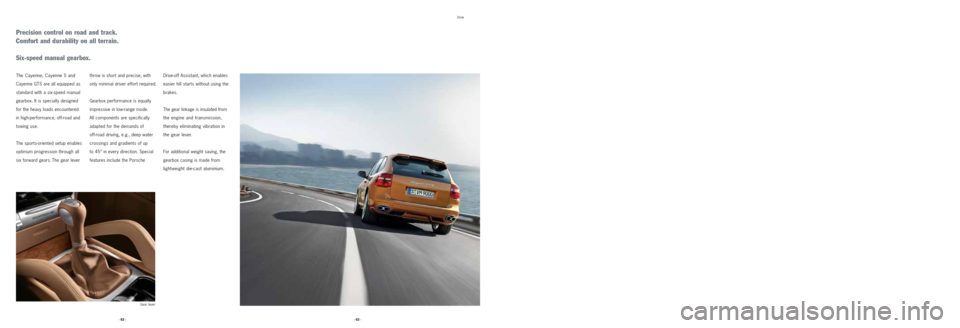
Drive
Precision control on road and track.
Comfort and durability on all terrain.
Six-speed manual gearbox.
Drive-off Assistant, which enables
easier hill starts without using the
brakes.
The gear linkage is insulated from
the engine and transmission,
thereby eliminating vibration in
the gear lever.
For additional weight saving, the
gearbox casing is made from
lightweight die-cast aluminium.
throw is short and precise, with
only minimal driver effort required.
Gearbox performance is equally
impressive in low-range mode.
All components are specifically
adapted for the demands of
off-road driving, e.g., deep water
crossings and gradients of up
to 45° in every direction. Special
features include the Porsche The Cayenne, Cayenne S and
Cayenne GTS are all equipped as
standard with a six-speed manual
gearbox. It is specially designed
for the heavy loads encountered
in high-performance, off-road and
towing use.
The sports-oriented setup enables
optimum progression through all
six forward gears. The gear lever
Gear lever
· 63 · · 62 ·
Page 30 of 95
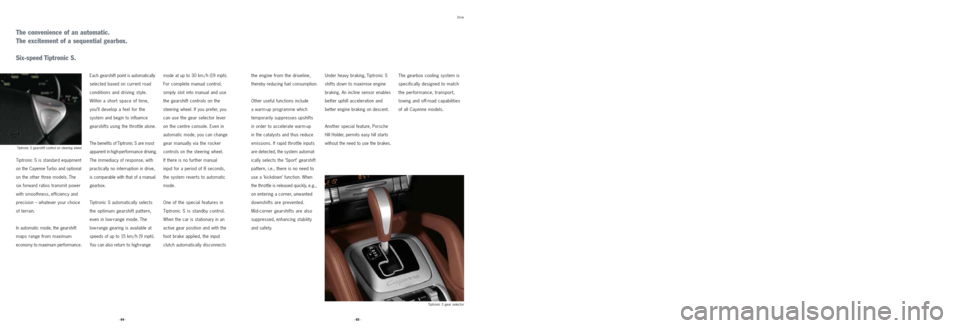
Drive
The convenience of an automatic.
The excitement of a sequential gearbox.
Six-speed Tiptronic S.
Each gearshift point is automatically
selected based on current road
conditions and driving style.
Within a short space of time,
you’ll develop a feel for the
system and begin to influence
gearshifts using the throttle alone.
The benefits of Tiptronic S are most
apparent in high-performance driving.
The immediacy of response, with
practically no interruption in drive,
is comparable with that of a manual
gearbox.
Tiptronic S automatically selects
the optimum gearshift pattern,
even in low-range mode. The
low-range gearing is available at
speeds of up to 15 km / h (9 mph).
You can also return to high-range
mode at up to 30 km / h (19 mph).
For complete manual control,
simply slot into manual and use
the gearshift controls on the
steering wheel. If you prefer, you
can use the gear selector lever
on the centre console. Even in
automatic mode, you can change
gear manually via the rocker
controls on the steering wheel.
If there is no further manual
input for a period of 8 seconds,
the system reverts to automatic
mode.
One of the special features in
Tiptronic S is standby control.
When the car is stationary in an
active gear position and with the
foot brake applied, the input
clutch automatically disconnects
the engine from the driveline,
thereby reducing fuel consumption.
Other useful functions include
a warm-up programme which
temporarily suppresses upshifts
in order to accelerate warm-up
in the catalysts and thus reduce
emissions. If rapid throttle inputs
are detected, the system automat-
ically selects the ‘Sport’ gearshift
pattern, i.e., there is no need to
use a ‘kickdown’ function. When
the throttle is released quickly, e.g.,
on entering a corner, unwanted
downshifts are prevented.
Mid-corner gearshifts are also
suppressed, enhancing stability
and safety.Under heavy braking, Tiptronic S
shifts down to maximise engine
braking. An incline sensor enables
better uphill acceleration and
better engine braking on descent.
Another special feature, Porsche
Hill Holder, permits easy hill starts
without the need to use the brakes.
The gearbox cooling system is
specifically designed to match
the performance, transport,
towing and off-road capabilities
of all Cayenne models.
Tiptronic S is standard equipment
on the Cayenne Turbo and optional
on the other three models. The
six forward ratios transmit power
with smoothness, efficiency and
precision – whatever your choice
of terrain.
In automatic mode, the gearshift
maps range from maximum
economy to maximum performance.
Tiptronic S gearshift control on steering wheel
Tiptronic S gear selector
· 65 · · 64 ·
Page 31 of 95
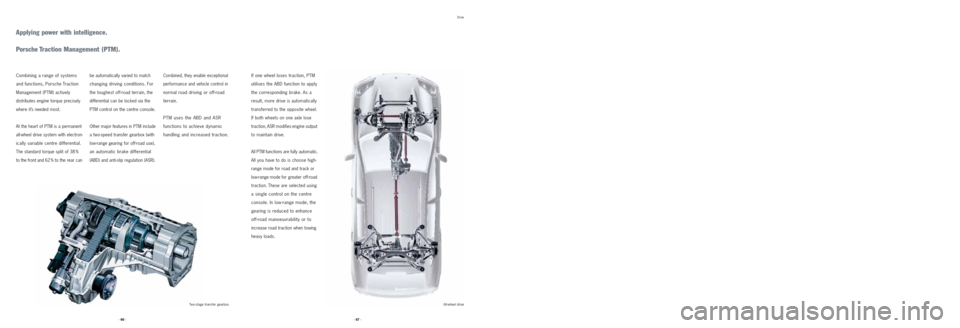
Drive
Applying power with intelligence.
Porsche Traction Management (PTM).
If one wheel loses traction, PTM
utilises the ABD function to apply
the corresponding brake. As a
result, more drive is automatically
transferred to the opposite wheel.
If both wheels on one axle lose
traction, ASR modifies engine output
to maintain drive.
All PTM functions are fully automatic.
All you have to do is choose high-
range mode for road and track or
low-range mode for greater off-road
traction. These are selected using
a single control on the centre
console. In low-range mode, the
gearing is reduced to enhance
off-road manoeuvrability or to
increase road traction when towing
heavy loads.
be automatically varied to match
changing driving conditions. For
the toughest off-road terrain, the
differential can be locked via the
PTM control on the centre console.
Other major features in PTM include
a two-speed transfer gearbox (with
low-range gearing for off-road use),
an automatic brake differential
(ABD) and anti-slip regulation (ASR).
Combining a range of systems
and functions, Porsche Traction
Management (PTM) actively
distributes engine torque precisely
where it’s needed most.
At the heart of PTM is a permanent
all-wheel drive system with electron-
ically variable centre differential.
The standard torque split of 38 %
to the front and 62 % to the rear canCombined, they enable exceptional
performance and vehicle control in
normal road driving or off-road
terrain.
PTM uses the ABD and ASR
functions to achieve dynamic
handling and increased traction.
All-wheel drive Two-stage transfer gearbox
· 67 · · 66 ·
Page 32 of 95
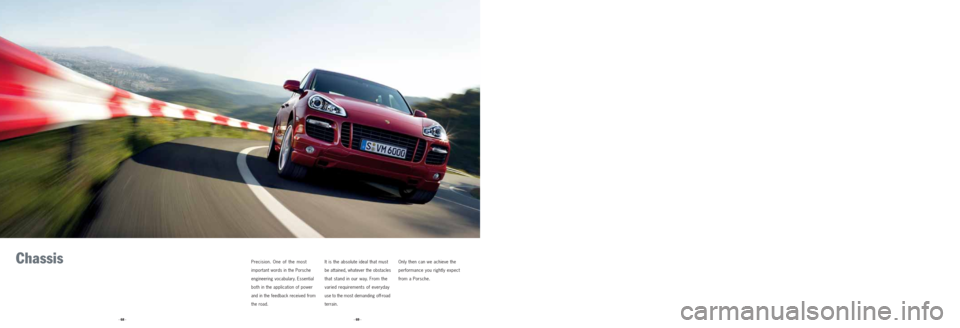
Chassis Precision. One of the most
important words in the Porsche
engineering vocabulary. Essential
both in the application of power
and in the feedback received from
the road.
It is the absolute ideal that must
be attained, whatever the obstacles
that stand in our way. From the
varied requirements of everyday
use to the most demanding off-road
terrain.
Only then can we achieve the
performance you rightly expect
from a Porsche.
· 69 · · 68 ·
Page 34 of 95
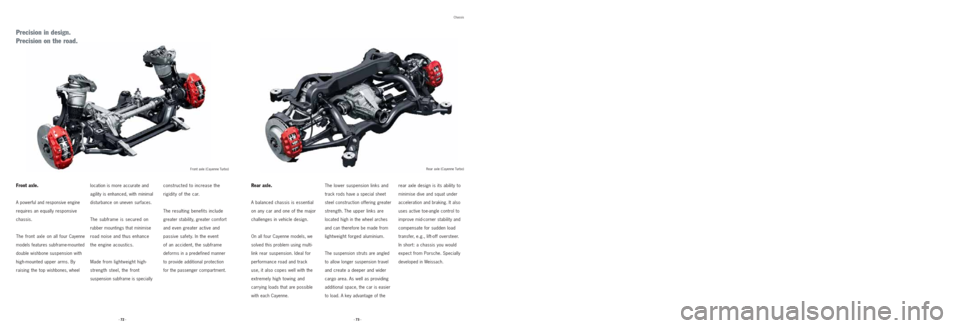
Chassis
Precision in design.
Precision on the road.
location is more accurate and
agility is enhanced, with minimal
disturbance on uneven surfaces.
The subframe is secured on
rubber mountings that minimise
road noise and thus enhance
the engine acoustics.
Made from lightweight high-
strength steel, the front
suspension subframe is specially
constructed to increase the
rigidity of the car.
The resulting benefits include
greater stability, greater comfort
and even greater active and
passive safety. In the event
of an accident, the subframe
deforms in a predefined manner
to provide additional protection
for the passenger compartment.
Front axle.
A powerful and responsive engine
requires an equally responsive
chassis.
The front axle on all fourCayenne
models features subframe-mounted
double wishbone
suspension with
high-mounted upper arms. By
raising the top
wishbones, wheel
Rear axle.
A balanced chassis is essential
on any car and one of the major
challenges in vehicle design.
On all four Cayenne models, we
solved this problem using multi-
link rear suspension. Ideal for
performance road and track
use, it also copes well with the
extremely high towing and
carrying loads that are possible
with each Cayenne.
The lower suspension links and
track rods have a special sheet
steel construction offering greater
strength. The upper links are
located high in the wheel arches
and can therefore be made from
lightweight forged aluminium.
The suspension struts are angled
to allow longer suspension travel
and create a deeper and wider
cargo area. As well as providing
additional space, the car is easier
to load. A key advantage of the
rear axle design is its ability to
minimise dive and squat under
acceleration and braking. It also
uses active toe-angle control to
improve mid-corner stability and
compensate for sudden load
transfer, e.g., lift-off oversteer.
In short: a chassis you would
expect from Porsche. Specially
developed in Weissach.
Front axle (Cayenne Turbo) Rear axle (Cayenne Turbo)
· 73 · · 72 ·
Page 36 of 95

Chassis
Active damping adjustment for optimum performance and comfort.
Porsche Active Suspension Management (PASM).
Both systems are optional on
the Cayenne and Cayenne S. The
Cayenne GTS has an exclusive
combination of PASM and high-
performance steel-sprung suspen-
sion (ride height lowered by 24 mm).
During performance driving or
heavy off-road use, there is a
greater tendency for the body
to roll. PASM prevents this from
happening, thereby improving
stability and occupant comfort.
PASM has three setup modes:
‘Comfort’, ‘Normal’ and ‘Sport’.
In all three cases, the system
uses a series of sensors to
monitor the movement of the
body, e.g., under acceleration and
braking or on poor road surfaces.
It also gathers data on lateral
acceleration, steering angle, brake
pressure and engine torque. The
PASM control unit then evaluates
this information and modifies the
damping forces in accordance
with the selected mode.
PASM remains active at
all times, adapting to the
changing conditions.
If the road surface deteriorates
while travelling in ‘Sport’ mode,
for instance, the system
immediately changes to a softer
rating, thereby improving road
contact. When the road surface
improves, PASM automatically
reverts to the original, harder
rating. This not only increases
stability and safety, it also
enhances comfort.
PASM is an electronic damping
control system. It offers continuous
adjustment of individual damping
forces based on current road
conditions and driving style. PASM
is standard on the Cayenne Turbo
in conjunction with air suspension.
· 77 · · 76 ·PASM control with ‘Comfort’, ’Normal’ and ‘Sport’ options
Page 41 of 95
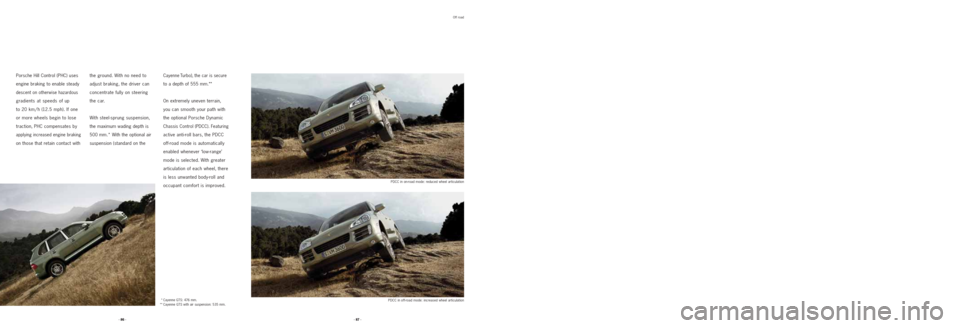
Off road
Porsche Hill Control (PHC) uses
engine braking to enable steady
descent on otherwise hazardous
gradients at speeds of up
to 20 km / h (12.5 mph). If one
or more wheels begin to lose
traction, PHC compensates by
applying increased engine braking
on those that retain contact withthe ground. With no need to
adjust braking, the driver can
concentrate fully on steering
the car.
With steel-sprung suspension,
the maximum wading depth is
500 mm.* With the optional air
suspension (standard on the
Cayenne Turbo), the car is secure
to a depth of 555 mm.**
On extremely uneven terrain,
you can smooth your path with
the optional Porsche Dynamic
Chassis Control (PDCC). Featuring
active anti-roll bars, the PDCC
off-road mode is automatically
enabled whenever ‘low-range’
mode is selected. With greater
articulation of each wheel, there
is less unwanted body-roll and
occupant comfort is improved.
PDCC in on-road mode: reduced wheel articulation
PDCC in off-road mode: increased wheel articulation
**Cayenne GTS: 476 mm.** Cayenne GTS with air suspension: 535 mm.
· 87 · · 86 ·
Page 42 of 95

Off road
Applying power with sensitivity, protecting with strength.
Off-road Technology package.
The rear differential enables
optimum distribution of engine
torque in difficult off-road terrain.
A fully automated part of the
all-wheel system, its primary
function is to optimise traction.
If one of the rear wheels begins
to lose grip, the differential varies
the torque transmitted through
each drive shaft, thereby restoring
traction. Available as a factory-fitted
option on all Cayenne models, the
Off-road Technology package*
incorporates an electronically
variable and lockable rear
differential as part of the standard
all-wheel drive system. Other
features include high-strength
rock-rails with integrated skid
plates, a reinforced engine-bay
guard, enhanced protection for
the fuel tank and rear axle, and
a second towing lug.In low-range mode, the rear
differential can be manually
locked using the main off-road
control on the centre console.
In this state, both rear wheels
receive the same amount of
torque.
For additional off-road protection,
optional wheel-arch extensions
(black finish) and running boards*
with integrated skid plates are
available.
* Not available for the Cayenne GTS.
· 89 · · 88 ·
Page 46 of 95
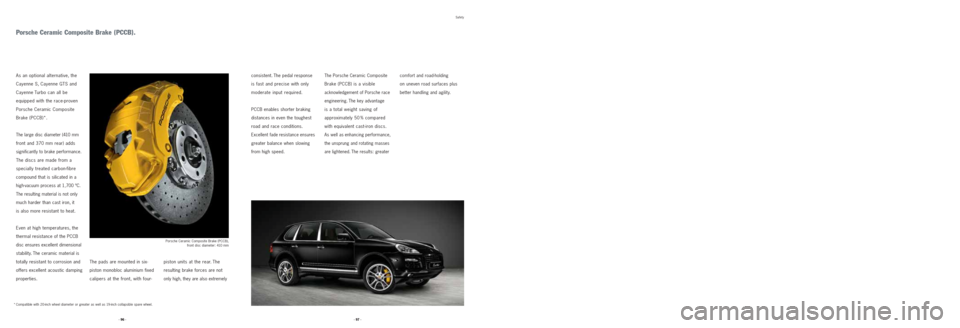
piston units at the rear. The
resulting brake forces are not
only high, they are also extremely
Porsche Ceramic Composite Brake (PCCB).
Porsche Ceramic Composite Brake (PCCB),
front disc diameter: 410 mm
The pads are mounted in six-
piston monobloc aluminium fixed
calipers at the front, with four-
Safety
As an optional alternative, the
Cayenne S, Cayenne GTS and
Cayenne Turbo can all be
equipped with the race-proven
Porsche Ceramic Composite
Brake (PCCB)*.
The large disc diameter (410 mm
front and 370 mm rear) adds
significantly to brake performance.
The discs are made from a
specially treated carbon-fibre
compound that is silicated in a
high-vacuum process at 1,700 ºC.
The resulting material is not only
much harder than cast iron, it
is also more resistant to heat.
Even at high temperatures, the
thermal resistance of the PCCB
disc ensures excellent dimensional
stability. The ceramic material is
totally resistant to corrosion and
offers excellent acoustic damping
properties.consistent. The pedal response
is fast and precise with only
moderate input required.
PCCB enables shorter braking
distances in even the toughest
road and race conditions.
Excellent fade resistance ensures
greater balance when slowing
from high speed.
· 97 · · 96 ·
The Porsche Ceramic Composite
Brake (PCCB) is a visible
acknowledgement of Porsche race
engineering. The key advantage
is a total weight saving of
approximately 50 % compared
with equivalent cast-iron discs.
As well as enhancing performance,
the unsprung and rotating masses
are lightened. The results: greater
comfort and road-holding
on uneven road surfaces plus
better handling and agility.
* Compatible with 20-inch wheel diameter or greater as well as 19-inch collapsible spare wheel.
Page 47 of 95
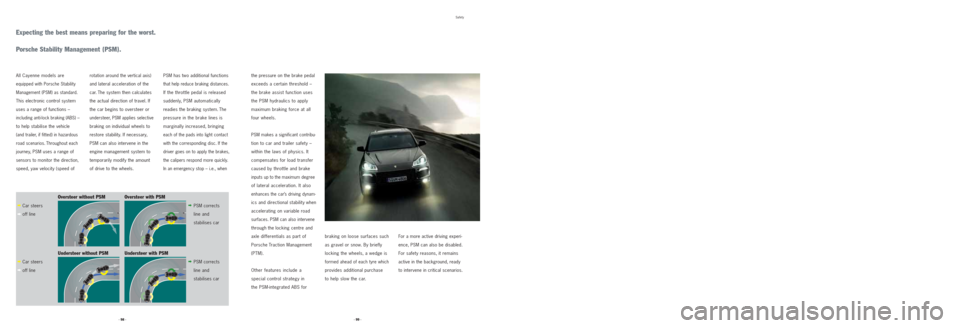
Oversteer with PSM
Understeer without PSM
Car steers
off line Car steers
off line PSM corrects
line and
stabilises car
PSM corrects
line and
stabilises car
Understeer with PSM Oversteer without PSM
All Cayenne models are
equipped with Porsche Stability
Management (PSM) as standard.
This electronic control system
uses a range of functions –
including anti-lock braking (ABS) –
to help stabilise the vehicle
(and trailer, if fitted) in hazardous
road scenarios. Throughout each
journey, PSM uses a range of
sensors to monitor the direction,
speed, yaw velocity (speed of
rotation around the vertical axis)
and lateral acceleration of the
car. The system then calculates
the actual direction of travel. If
the car begins to oversteer or
understeer, PSM applies selective
braking on individual wheels to
restore stability. If necessary,
PSM can also intervene in the
engine management system to
temporarily modify the amount
of drive to the wheels.PSM has two additional functions
that help reduce braking distances.
If the throttle pedal is released
suddenly, PSM automatically
readies the braking system. The
pressure in the brake lines is
marginally increased, bringing
each of the pads into light contact
with the corresponding disc. If the
driver goes on to apply the brakes,
the calipers respond more quickly.
In an emergency stop – i.e., when
the pressure on the brake pedal
exceeds a certain threshold –
the brake assist function uses
the PSM hydraulics to apply
maximum braking force at all
four wheels.
PSM makes a significant contribu-
tion to car and trailer safety –
within the laws of physics. It
compensates for load transfer
caused by throttle and brake
inputs up to the maximum degree
of lateral acceleration. It also
enhances the car’s driving dynam-
ics and directional stability when
accelerating on variable road
surfaces. PSM can also intervene
through the locking centre and
axle differentials as part of
Porsche Traction Management
(PTM).
Other features include a
special control strategy in
the PSM-integrated ABS for braking on loose surfaces such
as gravel or snow. By briefly
locking the wheels, a wedge is
formed ahead of each tyre which
provides additional purchase
to help slow the car.
For a more active driving experi-
ence, PSM can also be disabled.
For safety reasons, it remains
active in the background, ready
to intervene in critical scenarios.
Expecting the best means preparing for the worst.
Porsche Stability Management (PSM).
Safety
· 99 · · 98 ·